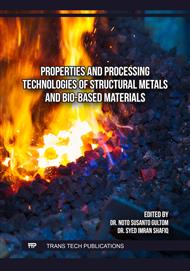[1]
The State of World Fisheries and Aquaculture 2022. FAO, 2022.
DOI: 10.4060/cc0461en
Google Scholar
[2]
A. Kustanto, "Water quality in Indonesia: The role of socioeconomic indicators," Jurnal Ekonomi Pembangunan, vol. 18, no. 1, p.47–62, Jul. 2020.
DOI: 10.29259/jep.v18i1.11509
Google Scholar
[3]
F. Bernardi, I. V. Zadinelo, H. J. Alves, F. Meurer, and L. D. dos Santos, "Chitins and chitosans for the removal of total ammonia of aquaculture effluents," Aquaculture, vol. 483, p.203–212, Jan. 2018.
DOI: 10.1016/j.aquaculture.2017.10.027
Google Scholar
[4]
U. Subhan, Iskandar, Zahidah, and I. M. Joni, "Detection of reserve oxygen potential in the present of fine bubbles and its ammonia removal for aquaculture effluent," in Materials Science Forum, Trans Tech Publications Ltd, 2021, p.103–111.
DOI: 10.4028/www.scientific.net/MSF.1044.103
Google Scholar
[5]
F. Alitaleshi, A. Daghbandan, and A. Pendashteh, "Performance of Rice Husk Biocarrier on Ammonia Nitrogen Removal in the MBBR Treating Aquaculture Wastewater Using Biological Attached Growth Process: Performance and Kinetic Study," J Environ Chem Eng, p.111446, Nov. 2023.
DOI: 10.1016/j.jece.2023.111446
Google Scholar
[6]
Q. Tong, G. Wang, M. Chen, Y. Chen, and Y. Guo, "Preparation and performance evaluation of novel magnetic porous carriers in fluidized bed bioreactor for wastewater treatment," Biodegradation, vol. 32, no. 6, p.677–695, Dec. 2021.
DOI: 10.1007/s10532-021-09960-z
Google Scholar
[7]
H.B. Carminati, P.S. Lima, A.R. Secchi, and J.P. Bassin, "Modeling and dynamic simulation of a two-stage pre-denitrification MBBR system under increasing organic loading rates," Bioprocess Biosyst Eng, vol. 41, no. 11, p.1573–1587, Nov. 2018.
DOI: 10.1007/s00449-018-1984-2
Google Scholar
[8]
M.C. Collivignarelli, A. Abbà, and G. Bertanza, "Oxygen transfer improvement in MBBR process," Environmental Science and Pollution Research, vol. 26, no. 11, p.10727–10737, Apr. 2019.
DOI: 10.1007/s11356-019-04535-1
Google Scholar
[9]
G. Proano-Pena, A. L. Carrano, and D. M. Blersch, "Analysis of very-high surface area 3D-printed media in a moving bed biofilm reactor for wastewater treatment," PLoS One, vol. 15, no. 8 August, Aug. 2020.
DOI: 10.1371/journal.pone.0238386
Google Scholar
[10]
L. H. Zhang, M. S. Zhang, J. B. Guo, Z. C. Chen, and L. X. Ling, "The performance and extracellular polymeric substances variations of an anaerobic-anoxic-oxic wastewater treatment process subjected to organic carbon and ammonia nitrogen shock loadings," Appl Ecol Environ Res, vol. 16, no. 5, p.6095–6112, 2018.
DOI: 10.15666/aeer/1605_60956112
Google Scholar
[11]
A. Shitu, S. Zhu, W. Qi, M. A. Tadda, D. Liu, and Z. Ye, "Performance of novel sponge biocarrier in MBBR treating recirculating aquaculture systems wastewater: Microbial community and kinetic study," J Environ Manage, vol. 275, Dec. 2020.
DOI: 10.1016/j.jenvman.2020.111264
Google Scholar
[12]
O. Elliott et al., "Design and Manufacturing of High Surface Area 3D-Printed Media for Moving Bed Bioreactors for Wastewater Treatment," J Contemp Water Res Educ, vol. 160, no. 1, p.144–156, 2017.
DOI: 10.1111/j.1936-704x.2017.03246.x
Google Scholar
[13]
R. Widjaya et al., "A Coin-Shaped Polypropylene Bio-Carrier Fabricated Using a Filament-Based 3D Printer for Wastewater Treatment," Defect and Diffusion Forum, vol. 428, p.55–61, 2023.
DOI: 10.4028/p-Ojyuu4
Google Scholar
[14]
S. Al-Amshawee and M. Y. B. M. Yunus, "Geometry of biofilm carriers: A systematic review deciding the best shape and pore size," Groundwater for Sustainable Development, vol. 12. Elsevier B.V., Feb. 01, 2021.
DOI: 10.1016/j.gsd.2020.100520
Google Scholar
[15]
S. Wang, S. Parajuli, V. Sivalingam, and R. Bakke, "Biofilm in Moving Bed Biofilm Process for Wastewater Treatment," 200AD. [Online]
DOI: 10.5772/intechopen.88520
Google Scholar
[16]
Y. Dong et al., "A Novel Bio-carrier Fabricated Using 3D Printing Technique for Wastewater Treatment," Sci Rep, vol. 5, Jul. 2015.
DOI: 10.1038/srep12400
Google Scholar
[17]
J. Loskot et al., "Influence of print speed on the microstructure, morphology, and mechanical properties of 3D-printed PETG products," Polym Test, vol. 123, Jun. 2023.
DOI: 10.1016/j.polymertesting.2023.108055
Google Scholar
[18]
M. Geiger and B. Rauch, "Diffusion depth: a crucial factor for MBBR carrier," Filtration and Separation, vol. 54, no. 1, p.30–32, Jan. 2017.
DOI: 10.1016/S0015-1882(17)30035-6
Google Scholar



